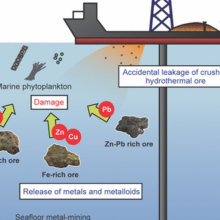Source: ACS Publications
Authors: Shigeshi Fuchida, Akiko Yokoyama, Rina Fukuchi, Jun-ichiro Ishibashi, Shinsuke Kawagucci, Masanobu Kawachi, and Hiroshi Koshikawa
Abstract: Seafloor massive sulfide deposits have attracted much interest as mineral resources. Therefore, the potential environmental impacts of full-scale mining should be considered. In this study, we focused on metal and metalloid contamination that could be triggered by accidental leakage and dispersion of hydrothermal ore particulates from mining vessels into surface seawater.
We determined the leaching potential of metals and metalloids from four hydrothermal ores collected from the Okinawa Trough into aerobic seawater and then evaluated the toxic effects of ore leachates on a phytoplankton species, Skeletonema marinoi–dohrnii complex, which is present ubiquitously in the ocean. Large amounts of metals and metalloids were released from the ground hydrothermal ores into seawater within 5 min under aerobic conditions. The main components of leachates were Zn + Pb, As + Sb, and Zn + Cu, which were obtained from the Fe–Zn–Pb-rich and Zn–Pb-rich zero-age, Ba-rich, and Fe-rich ores, respectively. The leachates had different chemical compositions from those of the ore. The rapid release and difference in chemical compositions between the leachates and the ores indicated that substances were not directly dissolved from the sulfide-binding mineral phase but from labile phases mainly on the adsorption–desorption interface of the ores under these conditions. All ore leachates inhibited the growth of S. marinoi–dohrnii complex but with different magnitudes of toxic effects. These results indicate that the fine particulate matter of hydrothermal ores is a potential source of toxic contamination that may damage primary production in the ocean. Therefore, we insist on the necessity for the prior evaluation of toxic element leachability from mineral ores into seawater to minimize mining impacts on the surface environment.
Continue reading here.
You can also find this publication on our website here.

